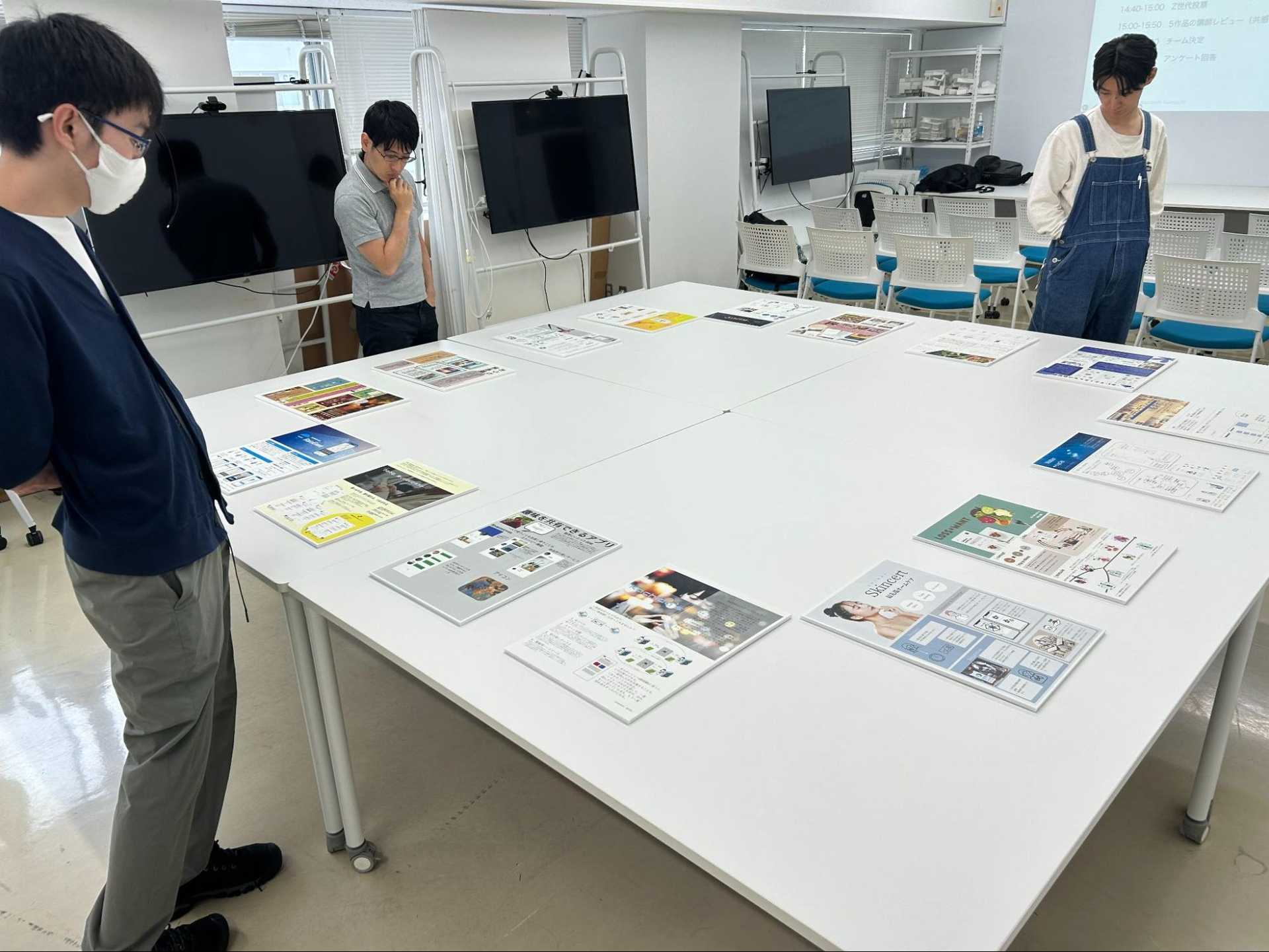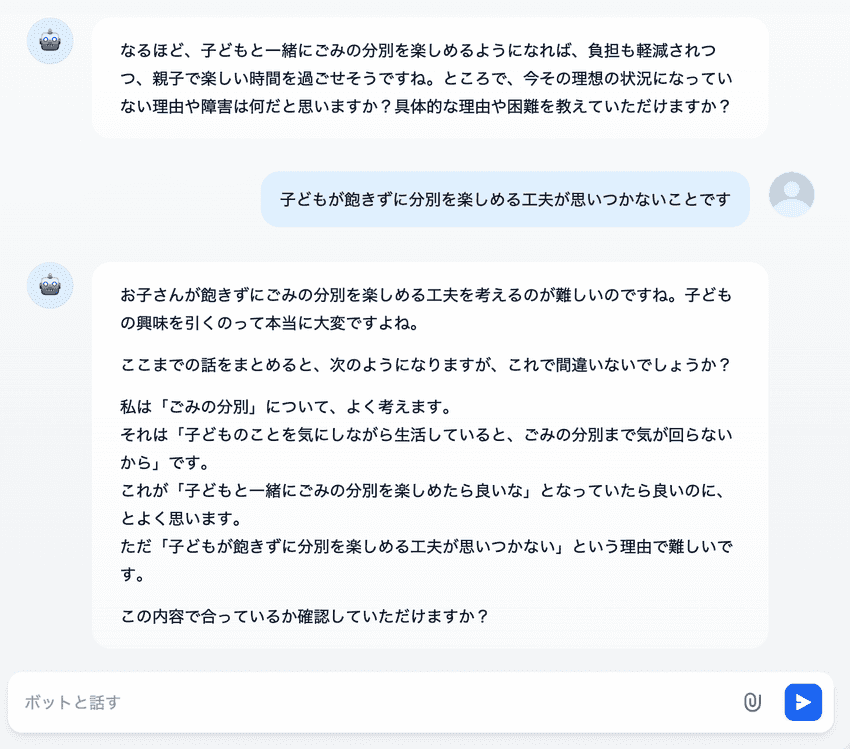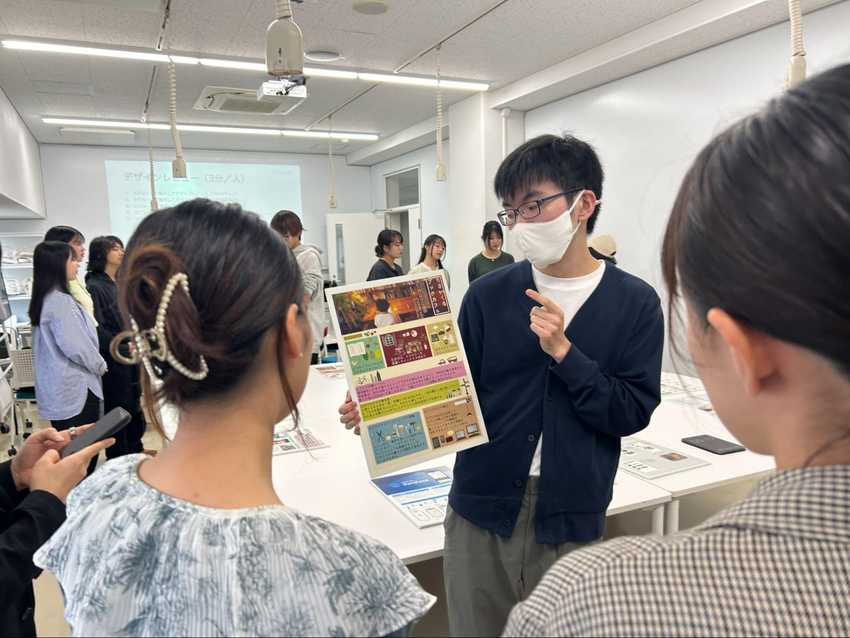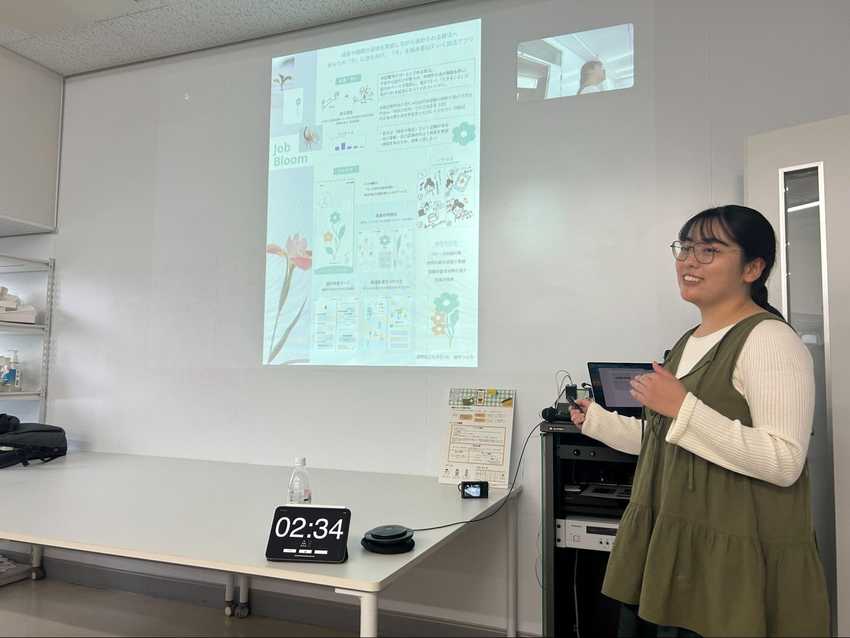In October and November 2024, Mercari R4D (“R4D”) and Yamaguchi University worked together on the “Design Project for Value Co-Creation to Encourage Environment-Aware Behavior in Gen Z for a Circular Economy.” This is part two of our report on this project.
Continuing on from part one, R4D Researcher Koki Kusano and Yamaguchi University Associate Professor Kazutoshi Sakaguchi review the session’s projects.
AI viability and problems when thinking of “personal design”
Sakaguchi: I would like to look back specifically on the individual work conducted during the first half of the design project, where students came up with ideas individually and presented them in a poster-format session. For this project, the students used three “AI navigators,” which were devised by Mercari R4D, to think of ideas based on the theme “personal design.”
- Personal navigator (deepening understanding of the self)
- Challenge navigator (supporting small experiments)
- Reflection navigator (collecting thoughts and making discoveries)
What was it like actually using AI?
Kusano: I feel like AI gave the students the potential to dive deep into what “personal” means to them. By trying out AI, students were able to discover firsthand that AI output isn’t always accurate. They also were able to experience moments of self-discovery, including what they truly value and want to express. I think AI helps open up such possibilities to an extent.
Sakaguchi: I felt that, while talking to an AI engine can help you gain a better understanding of your own thoughts, it can be quite limited in terms of expanding your perspective or suggesting ideas that resonate with other people. The ideas it suggests feel only loosely correlated with personal experiences and come off as someone else’s ideas. After the students talked to the AI engine and organized their thoughts, I think they were able to gain deeper insights and broaden their perspectives through speaking with others in person.
Kusano: It’s good to have time where you can share your thoughts like that. As you mentioned before, talking to the AI made the students realize that their personal ideas were deeper than they thought, and that some ideas were very niche and solely unique to them. At the poster presentation, one major topic of consideration was how people should talk to AI and how to facilitate interactions between people.
Kusano: What did you think of using AI to summarize ideas?
Sakaguchi: The students used the three AI navigators to compile their output into a single poster. These posters were hung up on a wall and presented for a design review by all the other participants. Doing this gave the students broader feedback than when talking to an AI engine, as they interacted with people live. One area the AI particularly excelled in was generating potential scenarios. The AI helped us to create quite detailed scenarios in a short amount of time. However, since it’s impossible to know how AI will process and output information, it was sometimes difficult for the students to visualize their thought processes and make decisions. The challenging thing about using AI is that it’s unclear how the information is processed and what criteria it uses to derive results. This made me realize that, in order to use AI effectively, design skills and guidance on how to appropriately interact with AI are crucial.
The difference between traditional “human-centered research” and “personal design”
Kusano: In this project, the teams ultimately came up with five different services based on the idea of “personal design.” Were there any aspects of these services that you found particularly impressive or interesting?
Sakaguchi: Traditional human-centered research involves surveying other people, but sometimes we don’t find the answers we are looking for through surveys. This project involved expanding ideas based on being interested in something, and I thought this method was also well-suited to creating new businesses. The process we used involved incorporating new contexts centered around human beings into existing contexts, which proved to be very effective. How about you, Kusano?
Kusano: I was impressed at how the students used trial and error to reimagine what they were trying to achieve systematically. Designs that took practicality into account, such as systems that can be used with peace of mind by incorporating realistic actors (elements), like the Faculty of Agriculture or Co-op, reflected systematic thinking and creative insights unique to the students.
Sakaguchi: The scope of the ideas shifted quite a bit. For instance, one team started with the simple idea of sharing umbrellas, which then evolved into the fundamental issue of “not wanting to get wet when it’s raining.” The design they ended up with was very impressive. The fact that they placed their idea in the right context and then expanded the idea from there was a really important factor. That tells me that it was important for teams to keep developing their ideas and being flexible in making changes, rather than being resistant to changing their original idea.
Kusano: I think we can do more in terms of not seeing objects as mere objects, and instead alter their value by associating them with stories or certain perspectives. Emphasizing the significance of recognizing this and thinking beyond the concerns we may have about objects as they are—focusing on the process of discovering value from a deeper perspective—is an indispensable process in service design.
Sakaguchi: In service design, we have to deal with both space and time, and dealing with time is particularly difficult. There are a lot of mapping tools to help with this, but they’re all fairly complicated, and of course controlling factors like time is incredibly challenging.
For the final proposals, each team created a video to introduce their service, and I think that allowed us to see the world through their eyes. It was great to see the students themselves acting in the videos, and I was impressed by their performances and presence on screen.
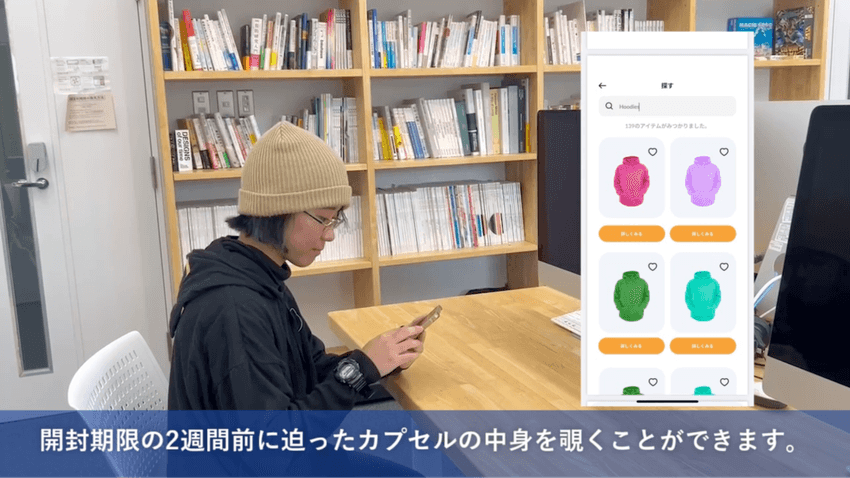 Screenshot from one video explaining service UX
Screenshot from one video explaining service UX
Kusano: Initially, the services the teams presented felt familiar. I wanted them to aim for something personal and something that would encourage people to try the service, and by incorporating that in their performance as well, the idea became something that we as users are also involved in, making the whole thing feel natural.
Sakaguchi: I agree. Since each service started from something personal to the students, I think they performed in a way that made sense to them.
Problems uncovered by the program and future approaches
Kusano: Looking back on everything now, I feel that there was great potential in collaborating with AI for the process of deepening what was personal to the students. However, using AI also comes with issues, such as relying too much on AI for ideas, or not being able to expand on some topics.
Also, in terms of service design, you lose some of the personal aspect when working in a team of three or four people, which meant that some teams adopted the “greatest common denominator” and produced a muddled result. I feel there was room for further improvement in the second half of the project in terms of how to continuously draw out insights that arise when thinking of “personal design.”
Ultimately, my goal is to link personal design to personal actions. But, we don’t have a clear answer as to how to make those actions continuous after the project ends. I think this is a topic we should pursue going forward.
Sakaguchi: I see. For me, seeing everyone use the provided generative AI tools throughout the project, I felt that we will need to clarify how to use the tools for different purposes going forward. Sometimes, you need to take an approach that shifts an idea to the extreme. I think using that kind of approach in this project was very effective in creating new services. Also, there’s still potential for the process of service design to evolve. In particular, it’s important to engage in service design while clearly defining the processes that humans should handle versus the processes that AI should handle.
Kusano: It was a really fun and interesting experience. It definitely felt more like a project than a series of lectures.
Sakaguchi: In that sense, the resources of both the university and the company meshed well to create an amazing educational program.
Kusano: This year the project dealt with a broad topic. However, focusing on a specific topic for a specific company, such as “redesigning Mercari as if it were your own,” could also be a viable approach, don’t you think? This project reminded me that it can be easy for universities and corporations to collaborate depending on the theme selected, and the approach you just mentioned can be applied to many different fields.
Sakaguchi: Finally, could you summarize the project in a few words?
Kusano: I am so thankful to all the students who participated in such an experimental initiative. It was very interesting, and I had a good time. It made me think of a lot of ways we could make things more interesting if we were to do something like this again. It was a very beneficial project. I hope, of course, that this was also a valuable learning opportunity for the students.
Sakaguchi: From the university’s perspective, we aim to advance education with a more practical approach, and our faculty in particular seeks to nurture global leaders. The students provided us with great topics and materials in terms of addressing social issues like the ones we talked about and figuring out how to solve them. I hope talented individuals continue to emerge in society.
Editor’s note: This project was also a valuable experience for us students who participated. The design approach we used emphasized a “personal perspective” and made it easier for us to imagine scenarios, while also allowing us to get hands-on experience of the design process necessary for creating new businesses, even if our perspective was sometimes narrow. Also, by utilizing generative AI, we were able to learn specific ways of engaging with AI in design. I would like to actively participate in opportunities for collaboration with companies and practical design exercises in the future. (By: Tsugumi Sakurai, 3rd year student of the Yamaguchi University Faculty of Global and Science Studies)
